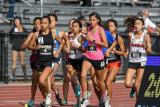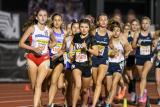Folders |
Running Issues: So You Want To Protect Girls' and Women's Sports?Published by
Seven Ways To Improve Conditions Without Banning Transgender Athletes By Elizabeth Carey for DyeStat Think the best way to support and elevate female athletes is to ban transgender athletes? Think again. The argument that banning transgender athletes protects girls’ and women’s sports is rooted in fear, hatred and misogyny. It clings to sports structures as they stand: caddywhompus and exclusive. Context matters. Have girls and women’s sports had wins worth celebrating? Yes. Have we made progress? Sure. Have countless lives been harmed, some irreparably, by archaic paradigms replicated through sport? Certainly. Does this continue today? Unfortunately, yes, progress is slow. For decades we’ve squeezed athletes into age-old structures and a climate of scarcity, too often at their expense. People tell girls and women they’re weaker, slower, and less powerful than boys and men. They hear myths that do not serve them: That puberty will ruin them, that periods are a hindrance, that they need to lose weight. That they should be careful, that they can’t wear just a sports bra at practice, that their competitions are boring. The binary is unequal. It exacerbates attacks against transgender people, as Athlete Ally states, whose human rights are being threatened by state legislation across the U.S. “If passed, these bills will cause significant, if not devastating, harm to our youth, families, and our communities,” as Running Industry Diversity Coalition board of directors said in a joint statement with Runners for Public Lands.
What if we, as a niche sporting community, considered that we are operating at limited capacity? That we have gaping holes in knowledge and awareness that trip up athletes vying for fanciful but vivid dreams? We have yet to reach the heights of girls’ and women’s athletic potential. If your priority is helping them reach new heights, there are at least seven efficient ways to do so so, without excluding transgender athletes and violating human rights. Changing tack by any of the following methods would benefit all athletes, not solely girls and women. 1. Invest Equally Provide equal opportunities for all athletes, from youth to the Olympic levels, which are both unbalanced. According to the Women’s Sports Foundation (WSF) and the National Federation of State High School Associations (NFHS), boys get 1.13 million more sport opportunities than girls each year. What’s more, girls of color have fewer athletic opportunities than those attending typically heavily white schools, according to WSF. Across the NCAA, 87 percent of schools offered disproportionately higher rates of athletic opportunities to male athletes compared to their enrollment in 2019. Equal investment in sports — from tracks and fields to coaches to equipment — would help level the field. Yet, according to WSF, in NCAA Divisions I and II, female athletes received 46 percent of athletic scholarship assistance; males received $240,435,504 more. That is not in compliance with Title IX, which bars sex discrimination. 2. Nix Diet Culture Diet culture — a belief and industry that values appearance, especially thinness — is detrimental, especially in a sport-specific context. Stop body shaming. Cease weigh-ins, restrictive eating, and body talk. Address fatphobia. Question assumptions about “racing weight” and other misguided concepts that confuse physics and metabolism. 3. Increase Diversity Actively combat racism within our teams, clubs, communities and industry. Hire more diverse staff, including pro athletes and coaches (Here are tips on how to do that from Running Industry Diversity Coalition. That includes women; Black, Indigenous, and People of Color (BIPOC). Pay them at least as much as the old boys. Check bias. 4. Continue Education As a profession, coaching lacks standard qualifications. Absent certification, credentialing, and even requiring continuing education, any Tom, Dick, or Harry with a connection or track record deemed decent can be — and stay — a coach. Coaches should be expected and required to learn, and keep learning, especially considering the evolving fields of sports medicine, kinesiology and exercise physiology (See: research including women). At the very least, they should be aware of Relative Energy Deficiency in Sport (RED-S), disordered eating and eating disorders, mental health, and the menstrual cycle and hormones. Bonus: study the power of positive coaching tactics. 5. Stop Armchair Experting A coach’s role is to identify and refer, as the NFHS training implores. Most coaches are neither psychologists nor physical therapists, and neither doctors nor registered dietitians. Rather, they should refer athletes demonstrating red flags to qualified specialists. Ideally, coaches have a list of properly credentialed and well-vetted experts who specialize in their athlete demographic, such as adolescent runners or postpartum women, and can support an athlete’s mental and physical health. While many coaches are legally mandatory reporters, every single one should prioritize the long-term wellbeing of the individuals in their care. That means paying attention to and advocating for your athletes. 6. Create Accountability Too often we hear stories of coaches abusing athletes — emotionally, sexually, and/or physically. Too often athletic administrations fail to support or protect athletes. The administrators in charge of the administrators (Ahem, NCAA) fail to do so, too. Ignoring issues, gaslighting, silencing and threatening athletes are all immoral abuses of power. Sexual abuse and illegal activities should not be tolerated or brushed under the rug. We need better recourse and actual accountability of coaches, administrations, and others with power over athletes. Does this mean expansion and more funding of SafeSport? Independent oversight of athletic departments? No more be-bopping-around of bad apples? Re-organization of collegiate and pro athletics? Or lawsuits? TBD, but likely yes to all of the above. 7. Let Athletes Out Of “Their Lanes” Unless an athlete is racing 800m or shorter, don’t tell them to stay in their lane. They’re whole humans. Currently, sports are about what rule-makers dictate. About whose body gets to do what. About the potential of skin sacks of bone, muscle, organs, tissues. About power, force, and control. Sports are a microcosm of the world at large into which athletes carry identities, obstacles, communities, joy, hope and dreams. Thing is, as Andraya Yearwood of Cromwell, Connecticut, pointed out in a DyeStat Discussion this week with Mary Albl, sports aren’t just about winning medals. "A lot of kids, if you’re trans or not, use sports to release some anger or stress or just to have fun, and to take transgender kids out this, you’re not allowed to express yourself through sports just because of who you are," Yearwood. said. "You’re in high school or middle school, these are kids. That’s not fair to who they are and their own development. I think it’s very detrimental to their emotional and mental state." Sports are about more than records, zero-sum games and exceptionalism. Can we see, celebrate, and grow them that way? ### Elizabeth Carey (https://elizabethwcarey.com/) is a writer and running coach based in Seattle, Washington. Her first book, GIRLS RUNNING, co-authored with Melody Fairchild, is available at your local bookstore and here: https://shop.aer.io/GirlsRunning/p/Girls_Running_All_You_Need_to_Strive_Thrive_and_Run_Your_Best/9781948007184-9934. |









